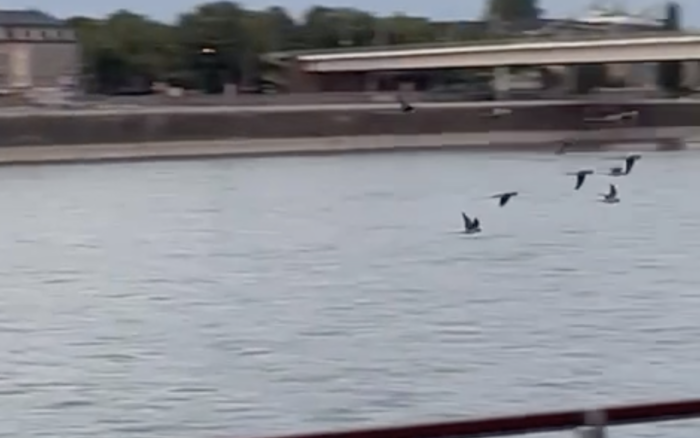While visiting Cologne, Germany, this month, I was surprised to see flocks of wild parrots skimming low over the waters of the Rhine before roosting in the large trees along the river’s edge. Parrots are not native to Germany but are probably descendants of pets that have escaped or been deliberately released, naturalizing in this region for 50 years. Still, I was shocked yet delighted to see them that evening and was reminded of my first encounter with wild parrots years ago in San Francisco on a cold Christmas Eve.
That morning I had just exited Beyond Expectations, a coffee shop near the corner of Spruce and Sacramento Streets, and was stunned to see an evergreen tree filled with green and red parrots. This area, also known as shrink row, is frequented by a range of patients and psychotherapists alike. A man, perhaps psychotic or under the influence, weaved by me as I stood in amazement. The parrots looked like Christmas ornaments, evenly perched over the tall tree. “They come every Christmas Eve,” he informed me.
San Francisco has always been extraordinary to me. I first saw the city in September 1971 as we drove south through Marin County on Highway 101 through what was then called the Waldo Tunnel. My friends and I had arrived in California the day before, driving days from the flat lands of the Midwest. As we exited the tunnel, the curved aperture of the tunnel’s end framed a majestic white city unlike any that I had known before. Chicago, St. Louis, and New York City featured brick buildings, darkened further from industry. But San Francisco, white and pastel, shined across the Bay like a palace emerging from the water.
We were young, in our early 20s. We had driven from Illinois, me to grad school in psychology, my friend Peggy wanting a job in the film industry and not realizing just how far north San Francisco is from Hollywood. Rich was along for the ride. He would visit his aunt living on the Peninsula before flying home.
What did we do that day that the magic wrapped around us like a starry wish, each of us full of hope and aspirations? I remember riding the cable car, standing on the sideboards, the breeze flapping the gathered skirt of the cotton-print, shirred-waisted dress my mother made. We meandered through Ghirardelli Square, enthralled with jugglers and musicians, with hippies selling their wares on the sidewalks, the air fresh with novelty. We had landed in another world.
I didn’t know it that day, but San Francisco would shape me. Like many West Coast residents, I naturalized in the Bay Area. I finished grad school, discovering the writings of Carl Jung and the C. G. Jung Institute of San Francisco, where I attended seminars and training. In time I would enter psychoanalysis, rent an office on Sacramento Street, and become a Jungian psychoanalyst myself.
I am still mesmerized by San Francisco’s beauty. The ocean cools and cleans the air; the steep streets defy the imagination of this Midwesterner, at least. It is a city small enough to know with no place to grow. Yes, it has troubles now. Like the rest of us, San Francisco suffers from the changes of the times: lack of affordable housing, a dying financial district, homelessness, and drug-related crime. But it has survived sobering challenges before. The 1906 earthquake and the ensuing fires destroyed 80% of the city, killing an estimated 3000 people. Within a decade, San Francisco had rebuilt to new fire and earthquake standards.[1]In the 1970s, thousands of gay men flocked to San Francisco’s Castro District to embrace newfound sexual freedom. Unfortunately, within a decade, nearly half of the city’s gay community had been lost to AIDS. Again, this same population’s activism worked for funding and education in getting antiviral drugs, which have stopped the diagnosis of HIV/AIDS from being a death sentence.[2]
So in April of this year, when San Franciscans voted the parrot to be the city’s official animal, they chose right. Like many of us, wild parrots are naturalized immigrants mysterious in origin, now having developed their own breed. From the first time I saw them resting in that tree on a cold winter’s day, I was filled with the openness of question and the inspiration of awe, both so important as we enter new territory.
San Francisco supervisor Aaron Pesky said the parrots (along with the other finalist, the sea lion) are “truly San Francisco characters: ornery, loud and opinionated.”[3] I like that. They know how to express themselves! Are they also harbingers of a warming climate? Probably. Wild—or feral parrots—as more exacting references call them, now are naturalizing on all continents except Antarctica. They bring a great gift to us through their mysterious history and adaptation: they are stimulators of imagination and models of resilience, offering hope that we, too, can survive the rapidly accelerating changes of our planet.
